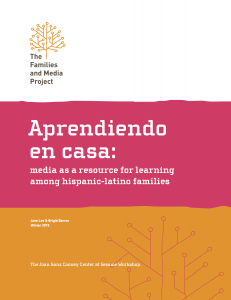
The Hispanic-Latino population is one of the largest—and most diverse—demographics in the U.S. Aprendiendo en casa reveals findings from a national survey of Hispanic parents about their home media environments and practices, and their perceptions of their children’s use of educational media across a range of different platforms. The report finds that there are significant gaps in access to computing devices and high speed Internet for children raised in English-only, bilingual and Spanish-speaking families. Families that speak primarily Spanish and which had the lowest incomes were least likely to have home Internet access or own computers, tablets, and e-readers. They were also least likely to say that their children access educational content through these technologies.
Aprendiendo en casa, by June Lee of Sesame Workshop and Brigid Barron of Stanford University, is based on findings from a survey that was conducted in English and Spanish with a nationally representative group of 682 Hispanic parents of children ages 2-10. The findings were derived from an analysis of the Hispanic subsample of parents that participated in a survey summarized in the Cooney Center’s Learning at Home report that was released in 2014.
The report was produced with the generous support of the Bezos Family Foundation, the Heising-Simons Foundation, AARP, and the LIFE Center as part of the Families and Media Project.




